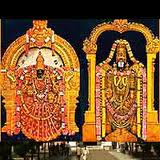Vaishakh Shukla 7, Kaliyug Varsha 5114
 PSLV-C19 satellite |
 Balaji |
Hyderabad : Traditions and beliefs trump science and technology in India, even when it concerns launching a rocket into space.Ahead of the blast-off of the PSLV-C19 satellite launcher, scheduled for Thursday, Indian Space Research Organisation (ISRO) scientists visited the Lord Venkateswara temple at Tirumala on Wednesday and sought the benediction of deity Balaji for the satellite’s flight into the outer space.
ISRO Chairman K Radhakrishnan, who led the team to Tirumala, carried a model of the PSLV-C19 and placed it at the feet of the deity in the sanctum sanctorum. “I came to pray for its successful flight,” Radhakrishnan told reporters later. Special rituals were performed by a team of temple priests led by chief priest Ramana Dikshitulu.
Temple authorities said the ritual by ISRO officials was not unusual as it had become a practice for public and private R&D institutions to seek the blessings on the eve of any test launch.
Indian scientists have been known to conduct religious rituals before any significant event, but Radhakrishnan, who has been in the eye of a storm over the recent controversy over ISRO’s deal with a private entity, has been criticised in the past for exhibiting his religious beliefs openly. Anticipating his elevation as ISRO chairman in October 2009, Radhakrishnan, a trained Kathakali dancer, camped at the Krishna temple at Guruvayoor temple, received his appointment order via the temple fax and had himself weighed in bananas in a thanksgiving ceremony called Tulabharam.
The PSLV-C19 is set for launch from Satish Dawan Space Centre in Sriharikota, Andhra Pradesh, on Thursday. The rocket will place in orbit a 1,850-kg remote sensing satellite, RISAT-1. The RISAT-1 has a synthetic aperture radar that enables it to take pictures of the earth even in bad weather. It will also act as a spy satellite.
The PSLV will launch a total of three satellites – Resource Sat-2 (RISAT), Youth Sat and X-Sats, into space. The three satellites weighing a total of 1,404 kg will be placed in orbit into space at an altitude of 822 km from the earth.The satellite will, however, send signals only after 25 days.
Source : Deccan Herald




